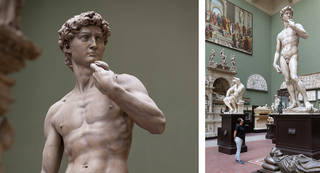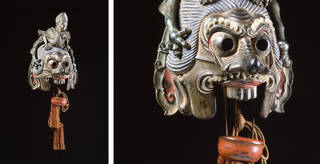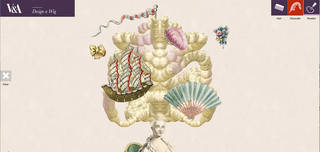Are you ready to go on an adventure? This trail takes you on a journey through V&A galleries, exploring some of the incredible cultures and traditions you can see. You will discover objects that are hundreds of years old, uncover secret meanings behind animals and colour in art, and learn about some of the wonders of the museum, from an emperor's throne to dragons, from plaster casts to wigs!
Where to go
To begin your adventure, head to the Cast Courts, Room 46a.
Stop 1: Trajan's Column, cast in 1864
Map link: Cast Courts, Room 46a, Level 0

Trajan's Column is the biggest object in the museum collection. Can you see it is split into two parts? This was so it could fit in the gallery! The column is a plaster copy of a stone monument, which was built almost 2,000 years ago in Rome, Italy. Look closely – the carvings illustrate famous battles that happened between the years 101 and 106 AD. There are 155 scenes that wind around the column from the bottom to the top, for over 200 metres.
There are more than 2,500 individual people and animals on the plaster casts. How many can you spot? Can you see any animals? What are they?

Stop 2: Plaster Cast of David, cast in 1856
Map link: Cast Courts, Room 46b, Level 0

This is a copy of a statue called David – the original statue is in Florence, Italy. The copy is made of lots of pieces of plaster fitted together. We know this because we were able to X-ray it to see what's inside. David's legs have two metal rods that support the inside of his thighs and enable him to stand up – just like human bones!
The statue is incredibly large. Standing in this space, you might feel like a giant is looking down on you. Can you think of any stories that feature giants? How would it feel to be so small surrounded by giants?

Stop 3: Ryo-O (Mask), 1450 – 1550
Map link: Japan, Room 45, Level 0

This mask represents the character Ryo-O (also known as Ranryo-O), the Dragon King. A performer would have worn it in a performance known as Bugaku, which mixes masked drama and dancing. It is carved from a single piece of wood, and the eyes are attached to a metal rod so the person wearing the mask could move them.
Look closely and you can see that the eyebrows and moustache have been added with tufts of white horsehair. Can you spot any other materials? If you were the Dragon King, what face would you make?

Stop 4: Samurai armour, assembled about 1850
Map link: Japan, Room 45, Level 0

The suits of armour for Japanese Samurai warriors were made from many different materials to protect them in battle. How many different materials can you spot on the armour?
The golden badges (called 'mon') on the helmet represent the family crest of the samurai. What symbols or patterns can you see?
Watch the short video in the gallery of the samurai putting on his armour. Imagine what it would have been like to wear in a battle. Try pulling a scary face like the samurai masks!

Stop 5: Imperial throne, 1775 – 80
Map link: China, Room 44, Level 0

The rulers of China would have sat on this throne almost 250 years ago. Red is a very important colour in China – it can symbolise festivities such as weddings, holidays and the New Year. There are also lots of symbols carved into the surface, like the patterns you see on robes. Look at the back of the throne – can you find the dragons, bats and fish?
Imagine you are an emperor or empress. What would it be like to sit on this throne? What rules would you make? Would you be mean or kind, lazy or hard-working, greedy or generous?

Stop 6: Octagonal fountain, about 1450
Map link: Medieval & Renaissance, Room 50a, Level 0

You are now standing in a Renaissance courtyard surrounded by sculptures. How many can you see? Look for this fountain with four lions guarding it. It's dry now, but once water would have spouted from the lions' mouths. The fountain was made for a garden more than 500 years ago.
How would you decorate a garden or a park? Would you choose flowers or water fountains? Would you include animals?

You're doing really well – why not take a break in our courtyard garden?
Map link: John Madejski Garden


Stop 7: Mosque lamp, 1320 – 1330
Map link: Islamic Middle East, Room 42, Level 0

Can you see the sword in the circle at the top of this mosque lamp? This was a symbol for a man called Qijlis (pronounced Kidge-Liss) who owned the lamp. What would your symbol be?
When making religious objects, Islamic artists never pictured people or animals. This is because when they were used, it might look as if people were praying to them and not to God. Instead, Islamic artists often decorated objects with rich colours, patterns, geometric shapes, plants or flowers and beautiful Arabic writing. Look around the gallery. Can you find other examples of these decorations?

Stop 8: 'Tippoo's Tiger', 1793
Map link: South Asia, Room 41, Level 0

There is a musical organ hidden inside this terrifying tiger. When you turn the handle on its side, the tiger growls and the man groans and lifts his arm up to fight the tiger off.
The model was made for Tipu Sultan who ruled Mysore in South India from 1782 – 1799. Tipu saw the tiger as a symbol of his strength. He was a powerful leader, but the British East India Company fought and killed him in 1799, and took this tiger from his palace to be displayed in Britain.
We cannot play the organ in the gallery but what noises do you think it makes? Can you imitate them? What animal would you choose to represent you?

Stop 9: Elephant, 12th century
Map link: South Asian Sculpture, Room 47b, Level 0

The Hindu god Aiyanar is riding this elephant. Aiyanar is the protector of villages and is often shown on a horse or an elephant. Look at the elephant, can you see what it's wearing? Can you see any other figures on the elephant's back?
Elephants are very strong animals. This elephant is holding something with its trunk. Can you see what it is? How would you carry all the things that this elephant is carrying? Can you spot other elephants in this gallery?

Stop 10: Join The Masquerade!
Map link: Europe 1600 – 1815, Room 2a, Level -1

Join the party at the Venetian Carnival as it would have been over 200 years ago with this interactive film. Dance at a ball, visit a gambling hall and watch a commedia dell'arte performance. Follow Harlequin and imitate his poses to move through your journey. Have fun!

Stop 11: Marie Antoinette, Queen of France, 1773
Map link: Europe 1600-1815, Room 2, Level -1

When Marie-Antoinette was queen of France it was fashionable for women to have huge hairstyles like this. To make their hair taller they sometimes used padding made of cow hair. They also used grease made from bear fat and big spiky pins to hold it all in place.
Look around these galleries to see what hairstyles other people are wearing in paintings, tapestries and on sculptures. How do you like to wear your hair? Create your own huge hairstyle with our Design a Wig game.


Stop 12: Head of an ox, 1650 – 1700
Map link: Europe 1600-1815, Room 6, Level -1

There is something strange about this ox head. When it was made over 300 years ago people were curious about, and a bit frightened by, examples of nature going wrong. By studying sick animals, doctors began to understand more about their illnesses.
What do you think is going on? What do you notice about the ox's eyes? Why do you think this ox was made? Was it for display in a house, a castle or a hospital?
Well done for exploring the V&A today – we hope you've had a great day!

